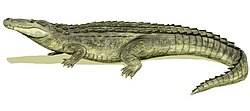| Tomistoma cairense | |
|---|---|
| Scientific classification | |
| Domain: | Eukaryota |
| Kingdom: | Animalia |
| Phylum: | Chordata |
| Class: | Reptilia |
| Clade: | Archosauria |
| Order: | Crocodilia |
| Family: | Gavialidae |
| Genus: | Tomistoma |
| Species: | T. cairense |
| Binomial name | |
| Tomistoma cairense Müller, 1927 [2] | |
Tomistoma cairense is an extinct species of gavialoid crocodilian from the Lutetian stage of the Eocene era. [3] It lived in North East Africa, especially Egypt. [3] Remains of T. cairense have been found in the Mokattam Formation, in Mokattam, Egypt. [4] Tomistoma cairense did not have a Maxilla process within their lacrimal gland, whereas all extant (living) crocodilians do. [5]
Below is a cladogram based morphological studies comparing skeletal features that shows Tomistoma cairense as a member of Tomistominae, related to the false gharial: [6]
| Crocodylidae |
| |||||||||||||||||||||||||||||||||||||||||||||||||||
Based on morphological studies of extinct taxa, the tomistomines (including the living false gharial) were long thought to be classified as crocodiles and not closely related to gavialoids. [7] However, recent molecular studies using DNA sequencing have consistently indicated that the false gharial (Tomistoma) (and by inference other related extinct forms in Tomistominae) actually belong to Gavialoidea (and Gavialidae). [8] [9] [10] [11] [12] [13] [14]
Below is a cladogram from a 2018 tip dating study by Lee & Yates simultaneously using morphological, molecular (DNA sequencing), and stratigraphic (fossil age) data that shows Tomistoma cairense as a gavialoid, more basal than the last common ancestor to both the gharial and the false gharial: [13]
| Gavialoidea |
| ||||||||||||||||||||||||||||||||||||||||||||||||||||||||||||||||||||||||||||||
| (stem-based group) |
Tomistoma cairense may need to be reclassified to a new genera, as studies have shown that its inclusion makes Tomistoma out to be paraphyletic. [6] [13]


